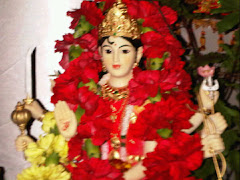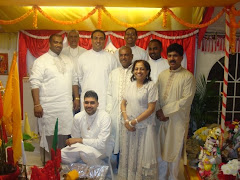Tuesday, February 2, 2010
Mandir Activity
Come join the Shri Ganapati Bhavan Family in Sunday Morning Devotion
Experience the warmth of a family environment and provide a spiritual ecosystem for yourself and family
Sunday Morning Devotion
Time:9:30AM Sunday, February 7th
Location:Shri Ganapati Bhavan Inc 109-39 Van Wyck Service Rd North Jamaica NY 11435
Contact : Suneel Rampersad: 917-440-6684
Officiating : Pundit Vishal M Maraj
सरस्वति नमस्तुभ्यं वरदे कामरूपिणि ।
विद्यारम्भं करिष्यामि सिद्धिर्भवतु मे सदा ॥
saraswati namastubhyam varade kamaroopini ।
vidyarambham karishyaami, siddhirbhavatu me sada ॥
O Saraswati, I bow to you, the giver of boons and the giver of form to desire. As I begin my studies, may success always be mine.
विद्यारम्भं करिष्यामि सिद्धिर्भवतु मे सदा ॥
saraswati namastubhyam varade kamaroopini ।
vidyarambham karishyaami, siddhirbhavatu me sada ॥
O Saraswati, I bow to you, the giver of boons and the giver of form to desire. As I begin my studies, may success always be mine.
Wednesday, January 20, 2010
Vasant Panchami
Vasant Panchami As 'Diwali' – the festival of light – is to Lakshmi, goddess of wealth and prosperity, and 'Navaratri' is to Durga, goddess of power and valor, Vasant Panchami is to Saraswati, the goddess of knowledge and arts. This festival is celebrated every year on the 5th day or ‘Panchami’ of the bright fortnight of the lunar month of Magha, which falls during January-February, . ‘Vasant’ comes from the word ‘spring’ as this festival heralds the beginning of the spring season. Birthday of Goddess Saraswati:It is believed that on this day goddess Saraswati was born. Hindus celebrate Vasant Panchami with great fervor in temples, homes and even schools and colleges. Saraswati’s favorite color yellow assumes special significance on this day. Statues of the goddess are dressed in yellow clothes and are worshiped by devotees adorning yellow garments. Saraswati is offered yellow colored sweets which are given away as ‘prasad’ to all people attending the ritual worship. There is also a custom of ancestor worship, known as ‘Pitri-Tarpan’ in many parts of India during Vasant Panchami. The Foundation of Education:The most significant aspect of Vasant Panchami is that it is also the most auspicious day to begin laying one’s foundations of education – of how to read and write. Pre-school children are given their first lesson in reading and writing on this day. All Hindu educational institutions conduct special prayer for Saraswati on this day. It is also a great day to inaugurate training institutes and new schools – a trend made famous by the renowned Indian educationist Pandit Madan Mohan Malaviya (1861-1946), who founded the Banaras Hindu University on Vasant Panchami day in 1916. A Springtime Celebration:During Vasant Panchami, the advent of spring is felt in the air as the season undergoes change. New leaves and blossoms appear in the trees with the promise of new life and hope. Vasant Panchami also announces the arrival of another big springtime event in the Hindu calendar - Holi, the festival of colors. Saraswati Vandana: Sanskrit Mantra:The following prayer is recited on this day: Yaa Kundendu tushaara haaradhavalaa, Yaa shubhravastraavritha
Yaa veenavara dandamanditakara, Yaa shwetha padmaasana
Yaa brahmaachyutha shankara prabhritibhir Devaisadaa Vanditha
Saa Maam Paatu Saraswatee Bhagavatee Nihshesha jaadyaapahaa
English Translation:"May Goddess Saraswati, who is fair like the jasmine-colored moon, and whose pure white garland is like frosty dew drops; who is adorned in radiant white attire, on whose beautiful arm rests the veena, and whose throne is a white lotus; who is surrounded and respected by the Gods, protect me. May you fully remove my lethargy, sluggishness, and ignorance."
Credits: S Das
Jai Ram Ji Ki
Pt Vishal
Yaa veenavara dandamanditakara, Yaa shwetha padmaasana
Yaa brahmaachyutha shankara prabhritibhir Devaisadaa Vanditha
Saa Maam Paatu Saraswatee Bhagavatee Nihshesha jaadyaapahaa
English Translation:"May Goddess Saraswati, who is fair like the jasmine-colored moon, and whose pure white garland is like frosty dew drops; who is adorned in radiant white attire, on whose beautiful arm rests the veena, and whose throne is a white lotus; who is surrounded and respected by the Gods, protect me. May you fully remove my lethargy, sluggishness, and ignorance."
Credits: S Das
Jai Ram Ji Ki
Pt Vishal
Tuesday, January 19, 2010
Saraswati Mantra
Saraswati is the goddess of arts, music, knowledge, and wisdom in the Hindu religion. Goddess Sarasvati is said to possess the powers of speech, wisdom and learning. Sarsvati is regarded as the dispeller of chaos and confusion. Saraswati Mantra is an important mantra of the Hindus that is recited for higher knowledge and wisdom. In India, people pray to her for guidance and knowledge. Maa Sarasvati Mantra is as follows:
"Yaa Kundendu Tushaara Haaradhavalaa, Yaa Shubhravastraavritha
Yaa Veenavara Dandamanditakara, Yaa Shwetha Padmaasana
Yaa Brahmaachyutha Shankara Prabhritibhir Devaisadaa Vanditha
Saa Maam Paatu Saraswati Bhagavatee Nihshesha Jaadyaapaha"

Meaning: Goddess Saraswati is fair and beautiful like the jasmine-colored moon. Her white garland resembles the icy dew drops. She is decked in pure white attire. A white lotus serves as the throne of Maa Saraswati, on whose arm rests Veena. We pray Maha Saraswati, who is surrounded and respected by the Gods to bestow her blessings on us. May the goddess remove our lethargy and brighten our life with light of knowledge.
Jai ram Ji Ki Pt Vishal
"Yaa Kundendu Tushaara Haaradhavalaa, Yaa Shubhravastraavritha
Yaa Veenavara Dandamanditakara, Yaa Shwetha Padmaasana
Yaa Brahmaachyutha Shankara Prabhritibhir Devaisadaa Vanditha
Saa Maam Paatu Saraswati Bhagavatee Nihshesha Jaadyaapaha"

Meaning: Goddess Saraswati is fair and beautiful like the jasmine-colored moon. Her white garland resembles the icy dew drops. She is decked in pure white attire. A white lotus serves as the throne of Maa Saraswati, on whose arm rests Veena. We pray Maha Saraswati, who is surrounded and respected by the Gods to bestow her blessings on us. May the goddess remove our lethargy and brighten our life with light of knowledge.
Jai ram Ji Ki Pt Vishal
Saraswati Jayanti (Vasant Panchami)
Host: Shri Ganapati Bhavan Inc
Type: Other - Ceremony
Network: Global
Date: Wednesday, January 20, 2010
Time: 6:30pm - 9:30pm
Location: Shri Ganapati Bhavan
Street: 109-39 Van Wyck Service Road (North)
Type: Other - Ceremony
Network: Global
Date: Wednesday, January 20, 2010
Time: 6:30pm - 9:30pm
Location: Shri Ganapati Bhavan
Street: 109-39 Van Wyck Service Road (North)
Hindu Dates January 2010
This Calendar is based on Longitude & Latitude
Trinidad and Tobago and New York City (Eastern Standard Time)
--------------------------------------------------------------------------------
Chowth 03
Ashtmi 08
Shattila Ekadashi 10
Monthly Shivraatri Makar Sankranti 13
Amaawasya 14
Gupa Nav Raatri begins 15
Panchak begins 1...7
Till Chaturthi 19
Saraswati Jayanti 20
Ashtmi 23
Gupta Nav Raatri ends 24
Jayaa Ekadashi 26
Pradosh 27
Poornima Vrat, Lalita Jayanti Maagh Snaan ends 29
Courtesy : Radio Jaagriti
Jai Ram Ji Ki
Pt Vishal
NOTE: please consult your Pundit for precise times and other information required.
Trinidad and Tobago and New York City (Eastern Standard Time)
--------------------------------------------------------------------------------
Chowth 03
Ashtmi 08
Shattila Ekadashi 10
Monthly Shivraatri Makar Sankranti 13
Amaawasya 14
Gupa Nav Raatri begins 15
Panchak begins 1...7
Till Chaturthi 19
Saraswati Jayanti 20
Ashtmi 23
Gupta Nav Raatri ends 24
Jayaa Ekadashi 26
Pradosh 27
Poornima Vrat, Lalita Jayanti Maagh Snaan ends 29
Courtesy : Radio Jaagriti
Jai Ram Ji Ki
Pt Vishal
NOTE: please consult your Pundit for precise times and other information required.
Monday, November 30, 2009
Concept Of Karma
Subject: Concept Of Karma The self-controlled person, moving among objects, with his senses free from attachment and malevolence and brought under his own control, attains tranquility.~ Bhagavad Gita II.64
The law of cause and effect forms an integral part of Hindu philosophy. This law is termed as 'karma', which means to 'act'. The Concise Oxford Dictionary of Current English defines it as the "sum of person's actions in one of his successive states of existence, viewed as deciding his fate for the next". In Sanskrit karma means "volitional action that is undertaken deliberately or knowingly". This also dovetails self-determination and a strong will power to abstain from inactivity. Karma is the differentia that characterizes human beings and distinguishes him from other creatures of the world. The Natural LawThe theory of karma harps on the Newtonian principle that every action produces an equal and opposite reaction. Every time we think or do something, we create a cause, which in time will bear its corresponding effects. And this cyclical cause and effect generates the concepts of samsara (or the world) and birth and reincarnation. It is the personality of a human being or the jivatman - with its positive and negative actions - that causes karma. Karma could be both the activities of the body or the mind, irrespective of the consideration whether the performance brings fruition immediately or at a later stage. However, the involuntary or the reflex actions of the body cannot be called karma. Your Karma Is Your Own DoingEvery person is responsible for his or her acts and thoughts, so each person's karma is entirely his or her own. Occidentals see the operation of karma as fatalistic. But that is far from true since it is in the hands of an individual to shape his own future by schooling his present. Hindu philosophy, which believes in life after death, holds the doctrine that if the karma of an individual is good enough, the next birth will be rewarding, and if not, the person may actually devolve and degenerate into a lower life form. In order to achieve good karma it is important to live life according to dharma or what is right. Three Kinds of KarmaAccording to the ways of life chosen by a person, his karma can be classified into three kinds. The satvik karma, which is without attachment, selfless and for the benefit of others; the rajasik karma, which is selfish where the focus is on gains for oneself; and the tamasik karma, which is undertaken without heed to consequences, and is supremely selfish and savage. In this context Dr. D N Singh in his A Study of Hinduism, quotes Mahatma Gandhi's lucid differentiation between the three. According to Gandhi, the tamasik works in a mechanic fashion, the rajasik drives too many horses, is restless and always doing something or other, and the satvik works with peace in mind. Swami Sivananda, of the Divine Life Society, Rishikesh classifies karma into three kinds on the basis of action and reaction: Prarabdha (so much of past actions as has given rise to the present birth), Sanchita (the balance of past actions that will give rise to future births - the storehouse of accumulated actions), Agami or Kriyamana (acts being done in the present life). The Discipline of Unattached ActionAccording to the scriptures, the discipline of unattached action (Nishkâma Karma) can lead to salvation of the soul. So they recommend that one should remain detached while carrying out his duties in life. As Lord Krishna said in the Bhagavad Gita: "To the man thinking about the objects (of the senses) arises attachment towards them; from attachment, arises longing; and from longing arises anger. From anger comes delusion; and from delusion loss of memory; from loss of memory, the ruin of discrimination; and on the ruin of discrimination, he perishes".
Credits: S Das
Jai Ram Ji Ki
Pt Vishal
The law of cause and effect forms an integral part of Hindu philosophy. This law is termed as 'karma', which means to 'act'. The Concise Oxford Dictionary of Current English defines it as the "sum of person's actions in one of his successive states of existence, viewed as deciding his fate for the next". In Sanskrit karma means "volitional action that is undertaken deliberately or knowingly". This also dovetails self-determination and a strong will power to abstain from inactivity. Karma is the differentia that characterizes human beings and distinguishes him from other creatures of the world. The Natural LawThe theory of karma harps on the Newtonian principle that every action produces an equal and opposite reaction. Every time we think or do something, we create a cause, which in time will bear its corresponding effects. And this cyclical cause and effect generates the concepts of samsara (or the world) and birth and reincarnation. It is the personality of a human being or the jivatman - with its positive and negative actions - that causes karma. Karma could be both the activities of the body or the mind, irrespective of the consideration whether the performance brings fruition immediately or at a later stage. However, the involuntary or the reflex actions of the body cannot be called karma. Your Karma Is Your Own DoingEvery person is responsible for his or her acts and thoughts, so each person's karma is entirely his or her own. Occidentals see the operation of karma as fatalistic. But that is far from true since it is in the hands of an individual to shape his own future by schooling his present. Hindu philosophy, which believes in life after death, holds the doctrine that if the karma of an individual is good enough, the next birth will be rewarding, and if not, the person may actually devolve and degenerate into a lower life form. In order to achieve good karma it is important to live life according to dharma or what is right. Three Kinds of KarmaAccording to the ways of life chosen by a person, his karma can be classified into three kinds. The satvik karma, which is without attachment, selfless and for the benefit of others; the rajasik karma, which is selfish where the focus is on gains for oneself; and the tamasik karma, which is undertaken without heed to consequences, and is supremely selfish and savage. In this context Dr. D N Singh in his A Study of Hinduism, quotes Mahatma Gandhi's lucid differentiation between the three. According to Gandhi, the tamasik works in a mechanic fashion, the rajasik drives too many horses, is restless and always doing something or other, and the satvik works with peace in mind. Swami Sivananda, of the Divine Life Society, Rishikesh classifies karma into three kinds on the basis of action and reaction: Prarabdha (so much of past actions as has given rise to the present birth), Sanchita (the balance of past actions that will give rise to future births - the storehouse of accumulated actions), Agami or Kriyamana (acts being done in the present life). The Discipline of Unattached ActionAccording to the scriptures, the discipline of unattached action (Nishkâma Karma) can lead to salvation of the soul. So they recommend that one should remain detached while carrying out his duties in life. As Lord Krishna said in the Bhagavad Gita: "To the man thinking about the objects (of the senses) arises attachment towards them; from attachment, arises longing; and from longing arises anger. From anger comes delusion; and from delusion loss of memory; from loss of memory, the ruin of discrimination; and on the ruin of discrimination, he perishes".
Credits: S Das
Jai Ram Ji Ki
Pt Vishal
Subscribe to:
Comments (Atom)




.jpg)






